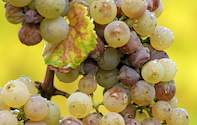Dead Arm Disease
Dead arm disease is caused by the Phomopsis viticola fungus. Symptoms include dark brown, lenticular lesions on the lower two to three internodes of the canes. It is visible early in the season, just after bud break.

This causes crop losses as the canes can easily break off at the lesions. Round yellow spots with a black dot in the middle appear on the leaves – it can easily be confused with damage caused by the paraquat herbicide. Dead arm disease is controlled from bud break to blooming. The canes with the lesions should be removed with pruning as these lesions cause new infections.
Botrytis
Botrytis begins as a light brown discoloration of the grape skin. The grape skin can slip away from the flesh (the most characteristic symptom) and under wet conditions, gray fungal spores can be seen on the grapes. It is caused by the Botrytis cinerea fungus and can lead to the making of noble rot white wines that are sought after due to their specific character.
In most cases botrytis leads to a poor harvest and low quality wines and red wines with an off-flavour. Botrytis can be controlled by spraying fungicides from flowering to harvest. Control from the start of colour break (when the berries start to ripen and change colour) until harvest time is very important.
Canopy management is necessary to reduce dense leaves - the thicker the leaves, the more the micro-climate around the grape bunches humidifies. This humid environment promotes the germination of botrytis spores. Good aeration also contribute to the rapid drying of the leaves after rain. Very vigorous, humid vineyards are more susceptible to this infection.
Therefore, restrict nitrogen fertilization to vulnerable areas in order to limit excessive leaf growth. In contaminated vineyards the infected vines should be removed and burned.
By Vinpro